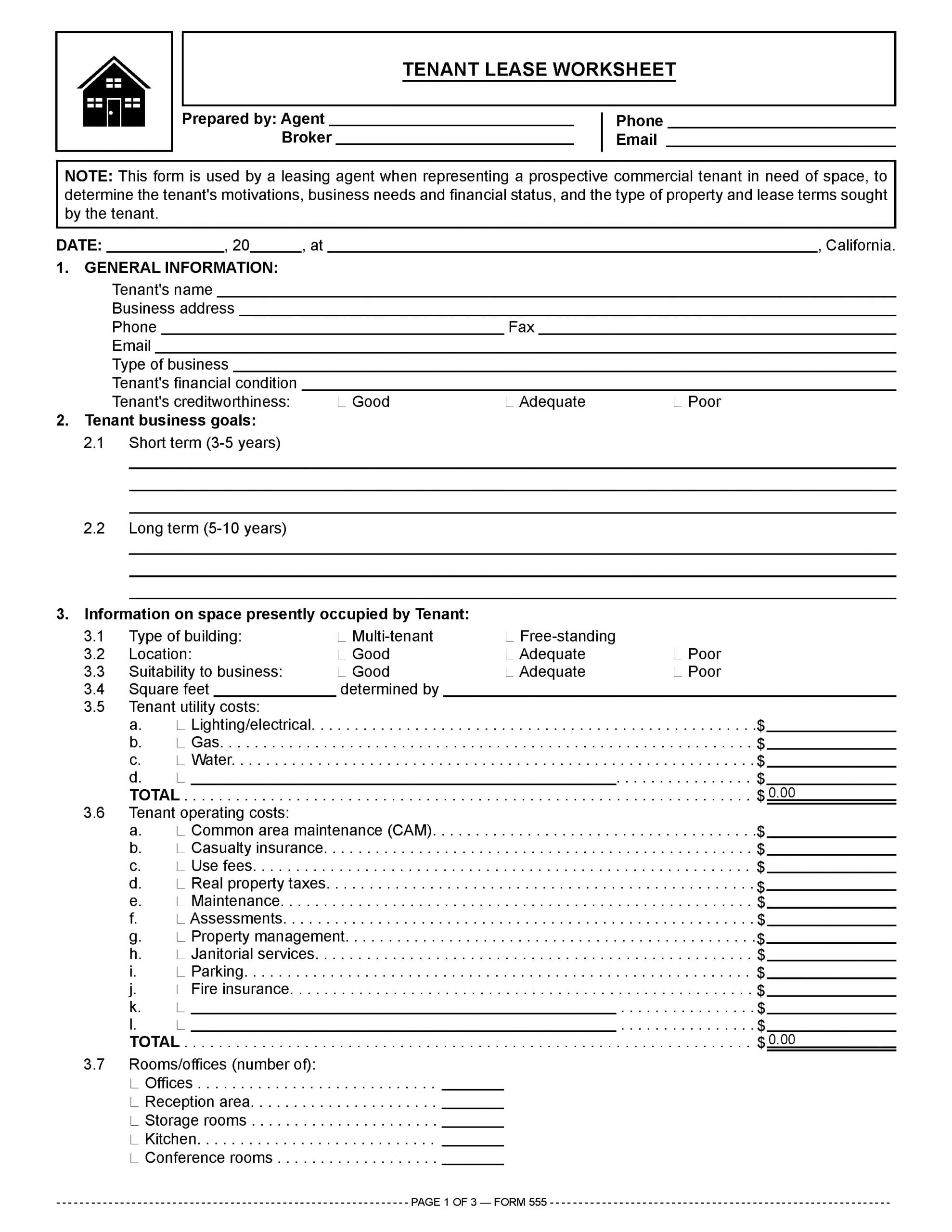Understanding a tenant’s intentions for leased property
To efficiently negotiate a commercial lease agreement on behalf of a tenant, a leasing agent needs to possess a high level of knowledge and expertise regarding the terms of a lease. A leasing agent best determines a tenant’s intentions for leasing property by preparing:
- a tenant lease worksheet to assess the tenant’s space requirements, and, with financial statements, the financial condition of the tenant’s business [See RPI Form 555]; and
- an offer to lease and attached lease agreement to commit the tenant so an acceptance by the landlord will bring about an enforceable contract set by the terms of a lease agreement or a viable counteroffer. [See RPI Form 556]
With or without a written retainer agreement with a tenant, the leasing agent who undertakes the task of locating space for the tenant assumes agency obligations to act in the best interest of the tenant client.
However, without a written agreement, the leasing agent has no assurance their fee, when earned, will be paid. [Phillippe v. Shapell Industries, Inc. (1987) 43 C3d 1247]
Thus, the prudent leasing agent only undertakes the duty to represent a tenant when the tenant signs an exclusive authorization to locate space. [See RPI Form 111]
A leasing agent acting on behalf of a tenant needs to investigate and confirm why the tenant wants to move to understand their client’s needs. [See RPI e-book Real Estate Property Management Chapter 15]
By uncovering the precise reasons for moving, the tenant’s agent is better able to find a suitable new location and premises or negotiate a renewal or extension of the tenant’s current lease.
Related article:
Using a tenant lease worksheet
The tenant lease worksheet covers three key areas the leasing agent needs to consider and analyze:
- the tenant’s current lease agreement obligations and conditions of their existing space;
- the tenant’s current and likely future needs for leased space; and
- the tenant’s financial condition and creditworthiness.
First, regarding the tenant’s existing space, the leasing agent will determine:
- the type of building;
- the square footage;
- the monthly operating and utility costs; and
- the tenant improvements (TIs) and trade fixtures.
A necessary review of the tenant’s current lease includes:
- the expiration date;
- monthly rent and periodic rent adjustments and assessments;
- the obligation to continue to occupy the premises;
- the obligation to restore the premises or remove TIs on expiration of the lease;
- options to extend or renew the lease or buy the premises from the landlord;
- the tenant’s ability to assign or sublease; and
- the amount of the security deposit currently held by the landlord.
These facts will help the leasing agent determine the tenant’s rights and obligations under their present lease for timing the tenant’s relocation. When representing the tenant, the leasing agent needs to explain their knowledge of the beneficial or detrimental effect any lease provisions have on the tenant.
Next, the leasing agent is to ascertain the tenant’s needs and operating goals for the new space.
Regarding the space requirements, the leasing agent needs to uncover the tenant’s:
- current square footage needs;
- future square footage needs;
- phone, utilities and computer facility needs;
- heating and air conditioning requirements;
- parking, docking, turn-around and shipping requirements;
- access to freeways, airports and other public transportation;
- access to civic, financial, legal, governmental or other “downtown” facilities;
- response time for police and fire departments;
- access to housing areas, shopping, restaurants and amenities; and
- any needs peculiar to the business operations of the tenant.
Finally, the leasing agent and tenant need to discuss the rental terms available in the leasing market. Several provisions in leases have a financial impact, favorable or not, on the landlord and tenant. Financial aspects of a lease agreement include:
- base monthly rent;
- periodic rental adjustments;
- payment of real estate taxes and insurance premiums;
- TIs;
- responsibility for general maintenance of the interior and exterior of the property;
- structural, roofing and HVAC maintenance;
- government ordered retrofitting;
- lease assignability and subletting authority;
- options to renew or extend, or to buy; and
- personal guarantees or letters of credit.
A leasing agent uses the Tenant Lease Worksheet published by Realty Publications, Inc. (RPI) when representing a prospective commercial tenant in need of space. The worksheet allows the leasing agent to precisely determine and document the tenant’s motivations, business needs and financial status, and the type of property and lease terms sought by the tenant. [See RPI Form 555]
Related article:
Contents of the offer to lease
An offer to lease needs to set forth all crucial elements negotiated to bring the landlord and tenant together in final leasing arrangements. [See RPI Form 556]
An offer to lease, like an offer to purchase, contains four primary sections:
- identification of the parties and premises;
- rental payment schedules and period of occupancy;
- property maintenance and terms of possession (use); and
- signatures of the parties.
A floor plan or common description of the premises is usually attached by a reference to it in the identification section.
The tenant is asked to include a good faith deposit. The check for the deposit needs to be made payable to a broker involved, not the landlord.
Upon receipt of the good faith deposit, the broker holds the deposit in a trust account as trust funds. When lease negotiations are unsuccessful, the broker returns the good faith deposit to the prospective tenant.
Related Video: Word-of-the-Week: Trust accounts
Click here for more information on this topic.
The section of the offer which sets forth the rental payment schedule is formatted as a checklist of various rental arrangements which may be selected by the tenant to structure their payment of rent, including:
- the duration/term of the initial leasing period;
- the monthly base rent for the first year;
- any rental adjustments during the leasing period for inflation and appreciation;
- responsibility for insurance policies, premium payment and payment of property taxes;
- the amount of the security deposit; and
- options to renew or extend the leasing period, or to buy the property.
It is good brokerage practice to reference and attach a copy of the proposed lease agreement form to the offer. The lease agreement includes boilerplate provisions covering:
- the responsibility for property operation and maintenance expenses [See RPI Form 552 §§5 and 6];
- the right to assign, sublet or encumber the lease [See RPI Form 552 §9];
- subordination/trust deed lender rights [See RPI Form 552 §17];
- default remedies [See RPI Form 552 §21]; and
- eminent domain. [See RPI Form 552 §19]
Some landlords, in response to an offer to lease, initially present prospective tenants with a fully prepared but unsigned lease agreement. This negotiation tactic works to the landlord’s advantage since it avoids any ambiguity over which lease document published by a given publisher is to be used. The participants then orally negotiate the final terms.
To better clarify negotiations, the broker writes up the offer to lease. Then, within the offer-counteroffer context, acceptable terms based on signed offers and counteroffers are developed. Expectations are properly reached, and negotiations are memorialized in writing to avoid later conjecture or discrepancies in memory.
The final section of the offer to lease is the signature section, where the landlord and tenant sign and agree to the terms stated in the offer.
By signing an offer to lease prepared by a broker, a prospective tenant initiates the negotiations in earnest on a property suitable for the tenant’s use. The landlord’s acceptance concludes the tenant’s search for space. [See RPI e-book Real Estate Property Management Chapter 16]
A leasing agent or prospective tenant uses the Offer to Lease form published by RPI when negotiating a rental or lease agreement for commercial space. It allows the tenant to make an offer on terms sufficiently complete to form a binding agreement on acceptance by the landlord. [See RPI Form 556]
Related FARM letter:
Want to learn more about this topic? Click the image below to download the RPI book cited in this article.

















